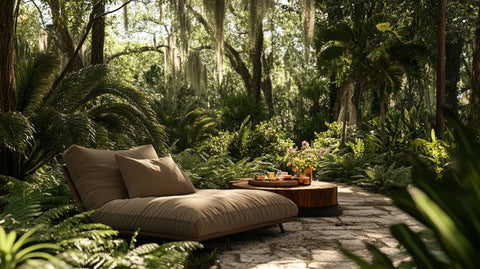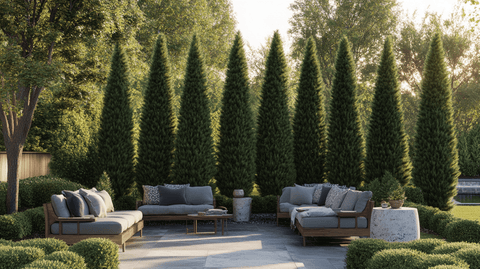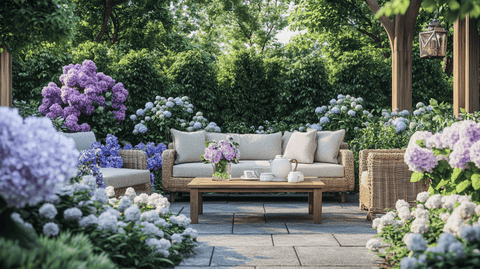Introduction
Florida, often celebrated for its sunshine, presents a unique challenge for gardeners and landscapers: how to cultivate lush, vibrant gardens in areas where the sun does not always shine. While sun-kissed landscapes dominate the visuals of the Sunshine State, shaded areas offer the perfect canvas for creating tranquil retreats that harmonize with Florida's natural beauty. Choosing the right plants for these areas can be a game-changer, especially when opting for native species that naturally thrive under such conditions.
Incorporating native plants into your Florida garden not only ensures that your landscape will flourish with minimal maintenance but also supports local wildlife and reduces the need for chemical interventions. This blog post explores some of the best native Florida plants for shaded environments, offering expert tips on landscaping with these resilient species as we subtly introduce you to some remarkable choices available at Plantology.

Understanding Florida’s Shaded Areas
Types of Shaded Environments
Before we dive into plant selections, it’s essential to understand the different types of shaded environments you might encounter in Florida gardens:
Full Shade
Full shade refers to areas that receive less than three hours of direct sunlight per day. This is typically found on the north side of buildings, under dense tree canopies or beneath sprawling verandas.
Partial Shade
Partial shade is an area that gets about three to six hours of sun daily, often during the cooler morning or later afternoon hours. Gardens on the east or west sides of buildings might experience such conditions.
Dappled Shade
Dappled shade occurs when sunlight filters through the leaves of trees, creating a speckled light pattern on the ground. This can be ideal for many plant species as it mimics the natural conditions of a forest understory.
Examples of Typical Shaded Garden Areas
No two shade gardens are alike, as the amount of light and the quality of soil can vary significantly. Common shaded garden areas include spaces beneath native live oaks, palm canopies, the north-facing sides of buildings, and along privacy fences where shadows prevail. Recognizing your garden's unique conditions is crucial to selecting the right plants that will thrive rather than just survive.
Benefits of Native Plants in Shaded Gardens
Adaptability
Florida’s native plants are naturally adapted to the local climate, soil types, and pest pressures. This inherent resilience makes them perfect candidates for shaded garden areas where conditions can fluctuate due to humidity, rainfall, and variable shade patterns.
Low Maintenance
One of the greatest benefits of opting for native plants is their low-maintenance nature. They typically require less water, fertilizers, and pesticides, reducing your garden's environmental impact while saving you time and money.
Attracting Local Wildlife
Native plants are vital for sustaining local wildlife populations, including pollinators like bees and butterflies as well as birds, which depend on specific plant species for food and habitat. A shaded garden rich in native species can become a lively ecosystem that supports biodiversity in your community.

Top Native Florida Plants for Shade
Coontie (Zamia pumila)
The Coontie is considered a relic of Florida's ancient past, a charming and hardy cycad that thrives in the understorey of pinelands and hammocks. Its feathery, evergreen fronds make it an attractive ground cover for both full and partial shade settings.
Firebush (Hamelia patens)
Though often associated with sunnier areas, the Firebush can adapt well to partial shade environments. This plant is prized for its bright orange-red tubular flowers, which bloom almost year-round, attracting hummingbirds and butterflies.
Southern Shield Fern (Thelypteris kunthii)
A quintessential shade-loving fern, the Southern Shield Fern is an ideal choice for full shade areas. Its bright green fronds add a lush, tropical touch to moist, shaded environments, spreading gently to create a verdant ground cover.
Beautyberry (Callicarpa americana)
Known for its striking clusters of magenta berries that appear in autumn, the Beautyberry thrives in partial shade. This deciduous shrub provides a habitat for birds and other wildlife, offering cover and food sources as summer winds down.
Wild Coffee (Psychotria nervosa)
This plant earns its name from the appearance of its berries and is favored for its glossy green leaves and small, white flowers. Wild Coffee does well in both full and partial shade, presenting an inviting ground cover for the local fauna.
Designing Your Shaded Garden
Layering and Structure
Master the art of layering with different plant heights and textures. Tall shrubs, medium perennials, and low-growing groundcovers can be strategically placed to create visual interest and biodiversity. For instance, taller plants like Wild Coffee can form a backdrop for mid-level Firebush and lower-lying ferns.
Color and Texture
Integrate various shades of green and diverse textures to enhance the allure of your shaded garden. Consider ferns for their delicate fronds, Coontie's architectural foliage, and the vibrant berries of Beautyberry for impressive seasonal displays.
Pathways and Seating Areas
Install winding pathways using mulch or stone to guide guests through your shaded haven. Benches or small seating nooks invite quiet reflection amid the natural ambiance. Such elements transform your garden into a tranquil escape.
Plantology’s Shaded Garden Collections

Adonidia Palm (Double, Single, Triple)
For a dramatic touch, consider our Adonidia Palm Double, Single, and Triple collections. While requiring some sun, these elegant palms can acclimatize to partial shaded areas in your garden, creating a tropical feel.
Aglaonema Silver Bay
Bring elegance to your space with the Aglaonema Silver Bay. Known for its stunning silver and green leaves, this indoor favorite can beautify shaded outdoor areas under trees or patios, perfect for pots and bedding.
How to Care for Shade-Loving Plants in Florida
Soil and Mulching
Most shade-loving plants prefer well-draining soil, rich in organic matter. Enhance the soil quality by adding compost and applying a layer of mulch. Mulch suppresses weed growth and retains soil moisture, which is crucial in shaded environments.
Watering
While shaded gardens can inhibit moisture evaporation, players must still monitor soil dryness. Watering must be adjusted based on weather conditions, with more needed during dry spells.
Pruning and Maintenance
Prune plants regularly to maintain desired shapes and sizes while removing dead or diseased branches. Pruning also encourages airflow and healthy growth, particularly important in covered areas.
Conclusion
Creating a thriving shaded garden in Florida is not only feasible but also rewarding with the right selection of native plants. By understanding your specific shade conditions and implementing strategic design elements, your garden can become a serene retreat that supports local ecology. Explore Plantology’s curated collections of shade-tolerant plants to kick-start or enhance your garden project, ensuring beauty and sustainability for years to come.
Discover more of our shade-friendly selections and shop Plantology today for plants that will enrich your garden’s shaded areas. Find these collections by visiting our online store at Plantology USA.
``` ```htmlAdvanced Plant Selection Considerations
Soil Composition and Amendments
Understanding the inherent soil composition in your shaded garden area is crucial for optimizing plant growth. Florida soils can vary widely, from sandy to clay or even loamy mixtures, and the presence of organic matter can significantly affect plant health.
Sandy soils, typical in many Floridian regions, may require the addition of organic materials like peat moss or well-rotted manure to improve water retention and nutrient availability. For areas with clay-based soil, consider incorporating sand or perlite to improve drainage. A soil test can provide valuable information on pH and nutrient levels, guiding any necessary amendments to create a conducive environment for native plant species.
Disease and Pest Management in Shaded Gardens
While native plants tend to be more resilient to local pests and diseases, shaded environments can sometimes promote damp conditions favorable to fungal issues. Monitoring for signs of disease such as leaf spots, mildew, or root rot is essential. Implementing good air circulation through proper plant spacing and pruning can mitigate these risks.
Introduce companion planting strategies by incorporating flora that naturally repel pests or attract beneficial insects. For example, marigolds and basil can deter unwanted pests, and the presence of flowering plants may invite pest-predators like ladybugs and lacewings.

Enhancing Biodiversity in Your Shade Garden
Biodiverse gardens not only support a wider range of wildlife but also promote a healthier garden ecosystem. Plant diversity encourages a balanced ecosystem that can naturally regulate pests and diseases. Consider the following strategies for enhancing biodiversity:
Incorporate a Variety of Plant Forms
Utilize a mix of vines, shrubs, ground covers, and trees to create a multi-layered garden. This approach not only provides various niches for wildlife but also increases the visual appeal of the garden. For instance, adding native vines like the crossvine (Bignonia capreolata) can offer vertical interest and additional habitats.
Seasonal Planting
Plan for year-round interest by selecting plants that bloom at different times of the year. This continuous availability of nectar and pollen supports pollinator populations and keeps the garden vibrant throughout the seasons. Mix spring-blooming trilliums with summer-blooming shade-tolerant azaleas and fall-fruit-bearing plants like the beautyberry.
Water Features and Habitats
Introduce water features like small ponds or bird baths to attract various wildlife, including amphibians and birds, further enriching your garden's ecosystem. Creating small rock or log piles can also offer shelter for creatures like lizards and beneficial garden insects.
Case Study: Transforming a Shaded Patio Garden
Consider the example of a small, urban patio garden located on the north side of a property, receiving predominantly dappled light throughout the day. The goal is to create an inviting and functional outdoor space integrating native plants.
Site Assessment and Planning
The patio environment was evaluated, noting its existing hardscape elements, moderate humidity, and seasonal shadow patterns cast by nearby buildings and mature trees. This information was crucial for selecting appropriate plant varieties and determining the layout.
- High-Traffic Areas: Before planting, pathways were clearly defined using stepping stones bordered by low-growing native ground covers like the twinflower (Dyschoriste oblongifolia), which withstand some foot traffic.
- Focal Points: The addition of a small fountain, surrounded by shade-adapted ferns and lush wild coffee plants created a focal point, serving as both a visual feature and a habitat for birds.
- Vertical Interest: Trellises with coral honeysuckle (Lonicera sempervirens) added vertical interest and color to an otherwise bland boundary wall, inviting hummingbirds into the space.
Outcome and Impact
The newly designed patio garden quickly surpassed expectations. Not only did it become a serene retreat for relaxation and entertaining, but it also increased visits from local pollinators and small birds, highlighting the impact of native plants in enhancing urban biodiversity.

Tips for Sustainability in Shaded Gardens
Rainwater Harvesting and Irrigation
Set up rain barrels to capture rainwater runoff from roofs or paved surfaces. This collected water can supplement irrigation efforts in shaded gardens, conserving municipal water resources. Employing drip irrigation directly to plant roots minimizes wastage and ensures precise water delivery.
Composting and Soil Fertility
Develop a composting system to recycle garden and kitchen waste. Regular applications of compost not only enrich the soil with nutrients but also improve its structure. It’s a cost-effective way to maintain soil health sustainably and reduce garden waste.
Reduce Chemical Inputs
Adopt natural pest management techniques instead of relying on chemical pesticides. Encourage natural predators, manually remove pests when possible, and use organic alternatives like neem oil or diatomaceous earth if necessary.
Expanding Your Shaded Garden: Ideas and Inspiration
Edible Shade Gardens
Contrary to common assumptions, shaded areas can also support a variety of edible plants. Consider planting shade-friendly crops like leafy greens, ginger, turmeric, or shade-tolerant herbs such as mint and cilantro. Employ raised beds or containers to maximize space and manage soil conditions effectively.
Creating Zen Gardens
Embrace the tranquility of shaded spaces by designing a Zen garden. Incorporate elements like raked gravel, rock features, and shade-loving mosses. Adding a Japanese maple can introduce vibrant seasonal color and shade interest with its delicately lobed leaves.
Incorporating Art and Lighting
Enhance the ambiance of your shaded garden by integrating art installations or lighting features. Solar-powered lights along pathways or uplighting on specimen trees create enchanting nighttime views. Sculpture pieces or water bowls can serve as artistic focal points within the garden.
Engage with the Plantology Community
Join the Plantology community and share your shaded garden journey! Whether you’re tackling a new garden project or seeking advice, our online forums are a hub for garden enthusiasts to exchange tips, celebrate successes, and inspire others.
Engage with us on social media or sign up for our newsletter for updates on new plant arrivals, gardening workshops, and exclusive promotions. Together, we can cultivate a greener, more sustainable world starting with your own backyard.
Don’t forget to explore Plantology’s comprehensive resource library, full of educational material on native plants, sustainable gardening practices, and design inspiration to help guide your gardening endeavors.

Conclusion
Building a shaded garden in Florida presents an exciting opportunity to blend functionality, sustainability, and beauty into an outdoor space that naturally aligns with local ecology. By selecting top-performing native plants and incorporating thoughtful design elements, your shaded garden can flourish into a personal sanctuary while fostering a valuable haven for local wildlife.
Venture into the world of shaded gardening by choosing from Plantology’s diverse selection of native plant collections. Let us support you in transforming your shaded spaces into thriving ecosystems that bring you joy and inspiration season after season.
Explore more from Plantology today, visit our online store and begin or expand your journey into the lush world of shaded Florida gardening at Plantology USA.
``` With the continuation above, the article offers a comprehensive guide to enhancing shaded gardens with a deep dive into specialized plant selections for unique conditions, sustainable practices, case studies, and opportunities for gardeners to engage and grow with a community of like-minded individuals. This encourages readers to embrace the natural shade-friendly beauty that Florida gardens can offer.





























Comments (0)
There are no comments for this article. Be the first one to leave a message!